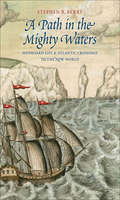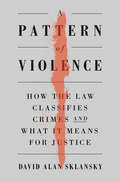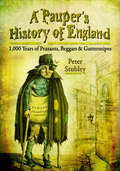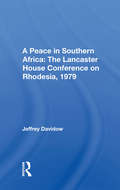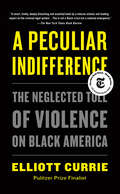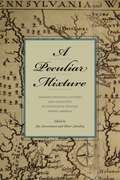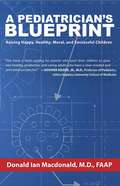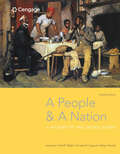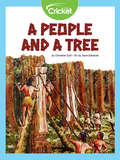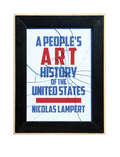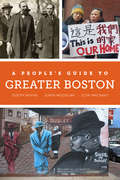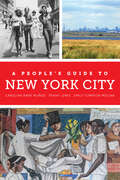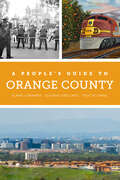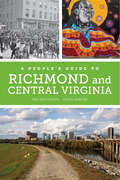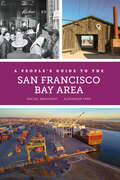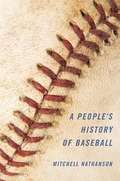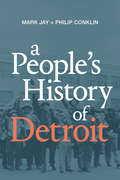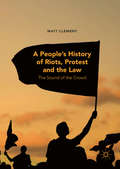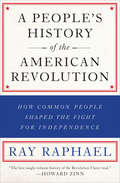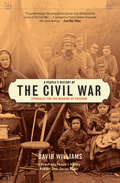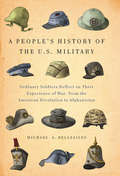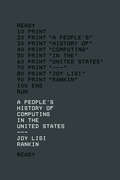- Table View
- List View
A Path in the Mighty Waters
by Prof. Stephen R. BerryIn October 1735, James Oglethorpe's Georgia Expedition set sail from London, bound for Georgia. Two hundred and twenty-seven passengers boarded two merchant ships accompanied by a British naval vessel and began a transformative voyage across the Atlantic that would last nearly five months. Chronicling their passage in journals, letters, and other accounts, the migrants described the challenges of physical confinement, the experiences of living closely with people from different regions, religions, and classes, and the multi-faceted character of the ocean itself.Using their specific journey as his narrative arc, Stephen Berry's A Path in the Mighty Waters tells the broader and hereto underexplored story of how people experienced their crossings to the New World in the eighteenth-century. During this time, hundreds of thousands of Europeans - mainly Irish and German - crossed the Atlantic as part of their martial, mercantile, political, or religious calling. Histories of these migrations, however, have often erased the ocean itself, giving priority to activities performed on solid ground. Reframing these histories, Berry shows how the ocean was more than a backdrop for human events; it actively shaped historical experiences by furnishing a dissociative break from normal patterns of life and a formative stage in travelers' processes of collective identification. Shipboard life, serving as a profound conversion experience for travelers, both spiritually and culturally, resembled the conditions of a frontier or border zone where the chaos of pure possibility encountered an inner need for stability and continuity, producing permutations on existing beliefs.Drawing on an impressive array of archival collections, Berry's vivid and rich account reveals the crucial role the Atlantic played in history and how it has lingered in American memory as a defining experience.
A Pattern of Violence: How the Law Classifies Crimes and What It Means for Justice
by David Alan SklanskyA law professor and former prosecutor reveals how inconsistent ideas about violence, enshrined in law, are at the root of the problems that plague our entire criminal justice system—from mass incarceration to police brutality. We take for granted that some crimes are violent and others aren’t. But how do we decide what counts as a violent act? David Alan Sklansky argues that legal notions about violence—its definition, causes, and moral significance—are functions of political choices, not eternal truths. And these choices are central to failures of our criminal justice system. The common distinction between violent and nonviolent acts, for example, played virtually no role in criminal law before the latter half of the twentieth century. Yet to this day, with more crimes than ever called “violent,” this distinction determines how we judge the seriousness of an offense, as well as the perpetrator’s debt and danger to society. Similarly, criminal law today treats violence as a pathology of individual character. But in other areas of law, including the procedural law that covers police conduct, the situational context of violence carries more weight. The result of these inconsistencies, and of society’s unique fear of violence since the 1960s, has been an application of law that reinforces inequities of race and class, undermining law’s legitimacy. A Pattern of Violence shows that novel legal philosophies of violence have motivated mass incarceration, blunted efforts to hold police accountable, constrained responses to sexual assault and domestic abuse, pushed juvenile offenders into adult prisons, encouraged toleration of prison violence, and limited responses to mass shootings. Reforming legal notions of violence is therefore an essential step toward justice.
A Pauper's History of England: 1,000 Years of Peasants, Beggars & Guttersnipes
by Peter StubleyA unique tour through British history—from the perspective of the peasants and the poverty-stricken. The past is traditionally told from the viewpoint of kings and queens, politicians and pioneers. But what about the people struggling to survive at the very lowest levels of society? A Pauper&’s History of England covers a thousand years of poverty, from Domesday right up to the twentieth century, via the Black Death and the English Civil War. It paints a portrait of what life was like for the peasants, paupers, beggars, and working poor as England developed from a feudal society into a wealthy superpower. Experience the past from a different perspective: Tour the England of the Domesday BookMake a solemn Franciscan vow of povertyJoin the Peasants&’ Revolt of 1381Converse with Elizabethan beggars and learn their secret languageMeet the inmates of Bedlam Hospital and Bridewell PrisonEnjoy a gin-soaked Georgian night of debaucherySpend the night in a workhouseGo slumming in Victorian London, and more!
A Peace In Southern Africa: The Lancaster House Conference On Rhodesia, 1979
by Jeffrey DavidowIn the middle of 1979 Rhodesia formed one leg of the triad of southern Africa's remaining white-ruled states. The country appeared no closer to peace and majority rule than it had at any time since Ian Smith's 1965 Unilateral Declaration of Independence. But by the end of that year a remarkable agreement had been forged that ended Rhodesia's rebell
A Peculiar Indifference: The Neglected Toll of Violence on Black America
by Elliott CurrieA NEW YORK TIMES NOTABLE BOOK OF THE YEARFrom Pulitzer Prize finalist Elliott Currie comes a devastating exploration of the extreme levels of violence afflicting Black communities, and a blueprint for addressing the crisis About 170,000 Black Americans have died in homicides just since the year 2000. Violence takes more years of life from Black men than cancer, stroke, and diabetes combined; a young Black man in the United States has a fifteen times greater chance of dying from violence than his white counterpart. Even Black women suffer violent death at a higher rate than white men, despite homicide’s usual gender patterns. Yet while the country has been rightly outraged by the recent spate of police killings of Black Americans, the shocking amount of “everyday” violence that plagues African American communities receives far less attention, and has nearly disappeared as a target of public policy. As acclaimed criminologist Elliott Currie makes clear, this pervasive violence is a direct result of the continuing social and economic marginalization of many Black communities in America. Those conditions help perpetuate a level of preventable trauma and needless suffering that has no counterpart anywhere in the developed world. Compelling and accessible, drawing on a rich array of both classic and contemporary research, A Peculiar Indifference describes the dimensions and consequences of this enduring emergency, explains its causes, and offers an urgent plea for long-overdue social action to end it.
A Peculiar Mixture: German-Language Cultures and Identities in Eighteenth-Century North America (Max Kade Research Institute)
by Jan Stievermann, Oliver ScheidingThrough innovative interdisciplinary methodologies and fresh avenues of inquiry, the nine essays collected in A Peculiar Mixture endeavor to transform how we understand the bewildering multiplicity and complexity that characterized the experience of German-speaking people in the middle colonies. They explore how the various cultural expressions of German speakers helped them bridge regional, religious, and denominational divides and eventually find a way to partake in America’s emerging national identity. Instead of thinking about early American culture and literature as evolving continuously as a singular entity, the contributions to this volume conceive of it as an ever-shifting and tangled “web of contact zones.” They present a society with a plurality of different native and colonial cultures interacting not only with one another but also with cultures and traditions from outside the colonies, in a “peculiar mixture” of Old World practices and New World influences. Aside from the editors, the contributors are Rosalind J. Beiler, Patrick M. Erben, Cynthia G. Falk, Marie Basile McDaniel, Philip Otterness, Liam Riordan, Matthias Schönhofer, and Marianne S. Wokeck.
A Peculiar Mixture: German-Language Cultures and Identities in Eighteenth-Century North America (Max Kade Research Institute: Germans Beyond Europe)
by Oliver Scheiding Jan StievermannThrough innovative interdisciplinary methodologies and fresh avenues of inquiry, the nine essays collected in A Peculiar Mixture endeavor to transform how we understand the bewildering multiplicity and complexity that characterized the experience of German-speaking people in the middle colonies. They explore how the various cultural expressions of German speakers helped them bridge regional, religious, and denominational divides and eventually find a way to partake in America’s emerging national identity. Instead of thinking about early American culture and literature as evolving continuously as a singular entity, the contributions to this volume conceive of it as an ever-shifting and tangled “web of contact zones.” They present a society with a plurality of different native and colonial cultures interacting not only with one another but also with cultures and traditions from outside the colonies, in a “peculiar mixture” of Old World practices and New World influences. Aside from the editors, the contributors are Rosalind J. Beiler, Patrick M. Erben, Cynthia G. Falk, Marie Basile McDaniel, Philip Otterness, Liam Riordan, Matthias Schönhofer, and Marianne S. Wokeck.
A Pediatrician's Blueprint
by Donald Ian MacdonaldA Pediatrician's Blueprint is written by an experienced pediatrician with the help of experts in various fields and using information gained from many sources that are cited. Parents have come to trust their pediatricians and the advice given by them. Rather than addressing the issues of nutrition, education, sex, drugs and drinking and violence as issues to be treated separately, this book sees the prevention of all best served by one common approach to parenting that stresses the setting of goals here enumerated and the development of a mission statement with a strategy for its implementation.Rather than approaching the parenting issues that are addressed in the other parenting books as single subjects, Donald Ian Macdonald, M.D., sees them all as part of the whole of parenting that involves knowing about your child, knowing how to be a 21st Century co-parent; knowing how to help your child to eventually separate from you and as a healthy goal oriented adult; and knowing how best to deal with the problems of inappropriate peer pressure, media messages, and time allocation.
A People Passing Rude
by Anthony CrossDescribed by the sixteenth-century English poet George Turbervile as "a people passing rude, to vices vile inclin'd", the Russians waited some three centuries before their subsequent cultural achievements--in music, art and particularly literature--achieved widespread recognition in Britain. The essays in this stimulating collection attest to the scope and variety of Russia's influence on British culture. They move from the early nineteenth century--when Byron sent his hero Don Juan to meet Catherine the Great, and an English critic sought to come to terms with the challenge of Pushkin--to a series of Russian-themed exhibitions at venues including the Crystal Palace and Earls Court. The collection looks at British encounters with Russian music, the absorption with Dostoevskii and Chekhov, and finishes by shedding light on Britain's engagement with Soviet film. Edited by Anthony Cross, one of the world's foremost authorities on Anglo-Russian relations, A People Passing Rude is essential reading for anyone with an interest in British and Russian cultures and their complex relationship.
A People and a Nation: A History of the United States
by Beth Bailey David W. Blight Carol Sheriff Mary Beth Norton Jane Kamensky Howard P. Chudacoff Fredrik LogevallThink history is dull? No way, and you're about to find out for yourself. A PEOPLE AND A NATION offers a lively narrative, telling the stories of the diverse peoples in the United States. The authors bring history to life by encouraging you to imagine what life was really like in the past. Focus questions and key terms (with definitions, of course) help you concentrate on important information and easily review it as you prep for tests. And with MindTap for A People and a Nation, you get convenient digital access to an ebook with note-taking and other time-saving features and apps. You'll also explore the people, events and places in the United States through interactive activities, videos, images and maps. Enjoy your journey.
A People and a Tree
by Christine GrafNative American tribes from the Northwest Coast learned to use the wood of cedar trees for many of their daily needs. Tribes used recycling to conserve resources hundreds of years ago. Pounding bark until it was fluffy to make diapers and with special thin branches called withes, cedar trees were soaked and used to make rope. What special technique did tribes use to take down big cedar trees?
A People's Art History of the United States
by Nicolas LampertMost people outside of the art world view art as something that is foreign to their experiences and everyday lives. A People's Art History of the United States places art history squarely in the rough-and-tumble of politics, social struggles, and the fight for justice from the colonial era through the present day.Author and radical artist Nicolas Lampert combines historical sweep with detailed examinations of individual artists and works in a politically charged narrative that spans the conquest of the Americas, the American Revolution, slavery and abolition, western expansion, the suffragette movement and feminism, civil rights movements, environmental movements, LGBT movements, antiglobalization movements, contemporary antiwar movements, and beyond.A People's Art History of the United States introduces us to key works of American radical art alongside dramatic retellings of the histories that inspired them. Stylishly illustrated with over two hundred images, this book is nothing less than an alternative education for anyone interested in the powerful role that art plays in our society.
A People's Guide to Greater Boston (A People's Guide Series #2)
by Joseph Nevins Suren Moodliar Eleni MacrakisA People's Guide to Greater Boston reveals the region’s richness and vibrancy in ways that are neglected by traditional area guidebooks and obscured by many tourist destinations. Affirming the hopes, interests, and struggles of individuals and groups on the receiving end of unjust forms of power, the book showcases the ground-level forces shaping the city. Uncovering stories and places central to people’s lives over centuries, this guide takes readers to sites of oppression, resistance, organizing, and transformation in Boston and outlying neighborhoods and municipalities—from Lawrence, Lowell, and Lynn to Concord and Plymouth. It highlights tales of the places and people involved in movements to abolish slavery; to end war and militarism; to achieve Native sovereignty, racial equity, gender justice, and sexual liberation; and to secure workers’ rights. In so doing, this one-of-a-kind guide points the way to a radically democratic Greater Boston, one that sparks social and environmental justice and inclusivity for all.
A People's Guide to New York City (A People's Guide Series #5)
by Penny Lewis Emily Tumpson Molina Carolina Bank MuñozThis alternative guidebook for one of the world’s most popular tourist destinations explores all five boroughs to reveal a people’s New York City. The sites and stories of A People’s Guide to New York City shift our perception of what defines New York, placing the passion, determination, defeats, and victories of its people at the core. Delving into the histories of New York's five boroughs, you will encounter enslaved Africans in revolt, women marching for equality, workers on strike, musicians and performers claiming streets for their art, and neighbors organizing against landfills and industrial toxins and in support of affordable housing and public schools. The streetscapes that emerge from these groups' struggles bear the traces, and this book shows you where to look to find them. New York City is a preeminent global city, serving as the headquarters for hundreds of multinational firms and a world-renowned cultural hub for fashion, art, and music. It is among the most multicultural cities in the world and also one of the most segregated cities in the United States. The people that make this global city function—immigrants, people of color, and the working classes—reside largely in the so-called outer boroughs, outside the corporations, neon, and skyscrapers of Manhattan. A People’s Guide to New York City expands the scope and scale of traditional guidebooks, providing an equitable exploration of the diverse communities throughout the city. Through the stories of over 150 sites across the Bronx, Manhattan, Queens, Brooklyn and Staten Island as well as thematic tours and contemporary and archival photographs, a people’s New York emerges, one in which collective struggles for justice and freedom have shaped the very landscape of the city.
A People's Guide to Orange County (A People's Guide Series #4)
by Gustavo Arellano Thuy Vo Dang Elaine LewinnekThe full and fascinating guidebook that Orange County deserves.A People’s Guide to Orange County is an alternative tour guide that documents sites of oppression, resistance, struggle, and transformation in Orange County, California. Orange County is more than the well-known images on orange crate labels, the high-profile amusement parks of Disneyland and Knott’s Berry Farm, or the beaches. It is also a unique site of agricultural and suburban history, political conservatism in a liberal state, and more diversity and discordance than its pop-cultural images show. It is a space of important agricultural labor disputes, segregation and resistance to segregation, privatization and the struggle for public space, politicized religions, Cold War global migrations, vibrant youth cultures, and efforts for environmental justice. Memorably, Ronald Reagan called Orange County the place "where all the good Republicans go to die," but it is also the place where many working-class immigrants have come to live and work in its agricultural, military-industrial, and tourist service economies. Orange County is the fifth-most populous county in America. If it were a city, it would be the nation’s third-largest city; if it were a state, its population would make it larger than twenty-one other states. It attracts 42 million tourists annually. Yet Orange County tends to be a chapter or two squeezed into guidebooks to Los Angeles or Disneyland. Mainstream guidebooks focus on Orange County’s amusement parks and wealthy coastal communities, with side trips to palatial shopping malls. These guides skip over Orange County’s most heterogeneous half—the inland space, where most of its oranges were grown alongside oil derricks that kept the orange groves heated. Existing guidebooks render invisible the diverse people who have labored there. A People’s Guide to Orange County questions who gets to claim Orange County’s image, exposing the extraordinary stories embedded in the ordinary landscape.
A People's Guide to Richmond and Central Virginia (A People's Guide Series #6)
by Melissa Dawn OotenAn expansive guide for resistance and solidarity across this storied region. Richmond and Central Virginia are a historic epicenter of America’s racialized history. This alternative guidebook foregrounds diverse communities in the region who are mobilizing to dismantle oppressive systems and fundamentally transforming the space to live and thrive. Featuring personal reflections from activists, artists, and community leaders, this book eschews colonial monuments and confederate memorials to instead highlight movements, neighborhoods, landmarks, and gathering spaces that shape social justice struggles across the history of this rapidly growing area. The sites, stories, and events featured here reveal how community resistance and resilience remain firmly embedded in the region’s landscape. A People’s Guide to Richmond and Central Virginia counters the narrative that elites make history worth knowing, and sites worth visiting, by demonstrating how ordinary people come together to create more equitable futures.
A People's Guide to the San Francisco Bay Area (A People's Guide Series #3)
by Rachel Brahinsky Alexander TarrAn alternative history and geography of the Bay Area that highlights sites of oppression, resistance, and transformation.A People’s Guide to the San Francisco Bay Area looks beyond the mythologized image of San Francisco to the places where collective struggle has built the region. Countering romanticized commercial narratives about the Bay Area, geographers Rachel Brahinsky and Alexander Tarr highlight the cultural and economic landscape of indigenous resistance to colonial rule, radical interracial and cross-class organizing against housing discrimination and police violence, young people demanding economically and ecologically sustainable futures, and the often-unrecognized labor of farmworkers and everyday people.The book asks who had—and who has—the power to shape the geography of one of the most watched regions in the world. As Silicon Valley's wealth dramatically transforms the look and feel of every corner of the region, like bankers' wealth did in the past, what do we need to remember about the people and places that have made the Bay Area, with its rich political legacies? With over 100 sites that you can visit and learn from, this book demonstrates critical ways of reading the landscape itself for clues to these histories. A useful companion for travelers, educators, or longtime residents, this guide links multicultural streets and lush hills to suburban cul-de-sacs and wetlands, stretching from the North Bay to the South Bay, from the East Bay to San Francisco. Original maps help guide readers, and thematic tours offer starting points for creating your own routes through the region.
A People's History of Baseball
by Mitchell NathansonFrom its first pitch, baseball has reflected national values and promoted the idea of what it means to be American. Beloved narratives tied the national pastime to beliefs as fundamental to our civic life as racial equality, patriotism, heroism, and virtuous capitalism. Mitchell Nathanson calls foul. Rejecting the myths and much-told tales, he examines how power is as much a part of baseball--and America--as pine tar and eye black. Indeed, the struggles for power within the game paralleled those that defined our nation. Nathanson follows the new Americans who sought club ownership to promote their social status in the increasingly closed caste system of nineteenth-century America. He shows how the rise and public rebuke of the Players Association reflects the collective spirit of working and middle-class America in the mid-twentieth century and the countervailing forces that sought to beat back the emerging movement. He lays bare the debilitating effects of a harsh double standard that required African American players to possess an unimpeachable character merely to take the field--a standard no white player had to meet. Told with passion and righteous outrage, A People's History of Baseball offers an incisive alternative history of America's much-loved--if misunderstood--national pastime.
A People's History of Detroit
by Mark Jay Philip ConklinRecent bouts of gentrification and investment in Detroit have led some to call it the greatest turnaround story in American history. Meanwhile, activists point to the city's cuts to public services, water shutoffs, mass foreclosures, and violent police raids. In A People's History of Detroit, Mark Jay and Philip Conklin use a class framework to tell a sweeping story of Detroit from 1913 to the present, embedding Motown's history in a global economic context. Attending to the struggle between corporate elites and radical working-class organizations, Jay and Conklin outline the complex sociopolitical dynamics underlying major events in Detroit's past, from the rise of Fordism and the formation of labor unions, to deindustrialization and the city's recent bankruptcy. They demonstrate that Detroit's history is not a tale of two cities—one of wealth and development and another racked by poverty and racial violence; rather it is the story of a single Detroit that operates according to capitalism's mandates.
A People's History of Riots, Protest and the Law: The Sound of the Crowd
by Matt ClementThis book examines how movements from below pose challenges to the status quo. The 2010s have seen an explosion of protest movements, sometimes characterised as riots by governments and the media. But these are not new phenomena, rather reflecting thousands of years of conflict between different social classes. Beginning with struggles for democracy and control of the state in Athens and ancient Rome, this book traces the common threads of resistance through the Middle Ages in Europe and into the modern age. As classes change so does the composition of the protestors and the goals of their movements; the one common factor being how groups can mobilise to resist unbearable oppression, thereby developing a crowd consciousness that widens their political horizons and demonstrates the possibility of overthrowing the existing order. To appreciate the roots and motivations of these so-called deviants the author argues that we need to listen to the sound of the crowd. This book will be of interest to researchers of social movements, protests and riots across sociology, history and international relations.
A People's History of the American Revolution: How Common People Shaped the Fight for Independence (A\new Press People's History Ser.)
by Ray Raphael&“The best single-volume history of the Revolution I have read.&” —Howard Zinn Upon its initial publication, Ray Raphael&’s magisterial A People&’s History of the American Revolution was hailed by NPR&’s Fresh Air as &“relentlessly aggressive and unsentimental.&” With impeccable skill, Raphael presented a wide array of fascinating scholarship within a single volume, employing a bottom-up approach that has served as a revelation. A People&’s History of the American Revolution draws upon diaries, personal letters, and other Revolutionary-era treasures, weaving a thrilling &“you are there&” narrative—&“a tapestry that uses individual experiences to illustrate the larger stories&”. Raphael shifts the focus away from George Washington and Thomas Jefferson to the slaves they owned, the Indians they displaced, and the men and boys who did the fighting (Los Angeles Times Book Review). This &“remarkable perspective on a familiar part of American history&” helps us appreciate more fully the incredible diversity of the American Revolution (Kirkus Reviews). &“Through letters, diaries, and other accounts, Raphael shows these individuals—white women and men of the farming and laboring classes, free and enslaved African Americans, Native Americans, loyalists, and religious pacifists—acting for or against the Revolution and enduring a war that compounded the difficulties of everyday life.&” —Library Journal &“A tour de force . . . Ray Raphael has probably altered the way in which future historians will see events.&” —The Sunday Times
A People's History of the Civil War: Struggles for the Meaning of Freedom (A\new Press People's History Ser.)
by David Williams&“Does for the Civil War period what Howard Zinn&’s A People&’s History of the United States did for the study of American history in general.&” —Library Journal Historian David Williams has written the first account of the American Civil War as viewed though the eyes of ordinary people—foot soldiers, slaves, women, prisoners of war, draft resisters, Native Americans, and others. Richly illustrated with little-known anecdotes and firsthand testimony, this path-breaking narrative moves beyond presidents and generals to tell a new and powerful story about America&’s most destructive conflict. A People&’s History of the Civil War is a &“readable social history&” that &“sheds fascinating light&” on this crucial period. In so doing, it recovers the long-overlooked perspectives and forgotten voices of one of the defining chapters of American history (Publishers Weekly). &“Meticulously researched and persuasively argued.&” —The Atlanta Journal-Constitution
A People's History of the Farmers' Movement, 2020–2021
by Sabah Siddiqui Shamsher SinghIn the annals of India’s history, a monumental uprising unfolded in 2020, echoing the resilience and coming together of large sections of its agrarian base. Instigated by the contentious farm laws of 2020, the Farmers’ Movement burgeoned into a year-long saga of protest and perseverance, ending only in December 2021 after the passing of the Farm Laws Repeal Bill, 2021 by the Indian Parliament. From the initial demand for law repeal to the multifaceted growth of the movement, the book traces the journey of the Farmers’ Movement, as each essay dissects the socio-political dynamics, cultural nuances, and mass solidarity that underpinned the protests, including focused analyses from Delhi, Punjab, Haryana, Uttar Pradesh, Rajasthan, Maharashtra, and the Sikh diaspora in the United Kingdom. This anthology chronicles the ebb and flow of a nation’s spirit, encapsulating the symbiotic relationship between theory and praxis, between change and continuity. It serves as a testament to the power of collective resistance and a roadmap for future struggles, ensuring that the legacy of the Farmers’ Movement endures beyond the pages of history.This volume is an interdisciplinary project and will be of interest to scholars from diverse fields such as economics, sociology, public policy, political science, history, political geography, gender studies, cultural studies, international studies, architecture, media studies, psychology, and ethnomusicology.
A People's History of the U.S. Military
by Michael A. BellesilesIn A People's History of the U.S. Military, historian Michael A. Bellesiles draws from three centuries of soldiers' personal encounters with combat-through fascinating excerpts from letters, diaries, and memoirs, as well as audio recordings, film, and blogs-to capture the essence of the American military experience firsthand, from the American Revolution to the wars in Iraq and Afghanistan.Military service can shatter and give meaning to lives; it is rarely a neutral encounter, and has contributed to a rich outpouring of personal testimony from the men and women who have literally placed their lives on the line. The often dramatic and always richly textured first-person accounts collected in this book cover a wide range of perspectives, from ardent patriots to disillusioned cynics; barely literate farm boys to urbane college graduates; scions of founding families to recent immigrants, enthusiasts, and dissenters; women disguising themselves as men in order to serve their country to African Americans fighting for their freedom through military service.A work of great relevance and immediacy-as the nation grapples with the return of thousands of men and women from active military duty-A People's History of the U.S. Military will become a major new touchstone for our understanding of American military service.
A People’s History of Computing in the United States
by Joy Lisi RankinDoes Silicon Valley deserve all the credit for digital creativity and social media? Joy Rankin questions this triumphalism by revisiting a pre-PC time when schools were not the last stop for mature consumer technologies but flourishing sites of innovative collaboration—when users taught computers and visionaries dreamed of networked access for all.
